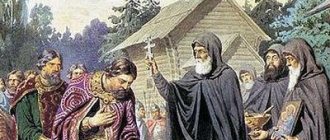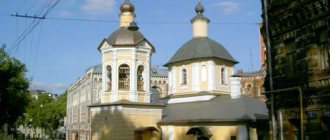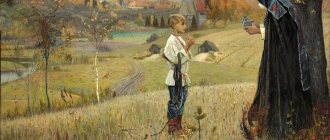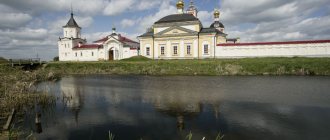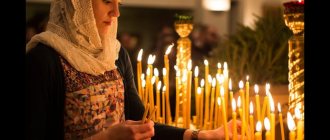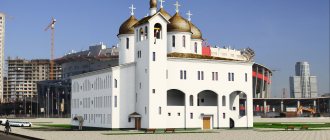Epiphanius the Wise, an outstanding historian and writer, a contemporary of Sergius of Radonezh and Stephen of Perm, left for posterity invaluable information about the spread of Christianity in the Middle Ages in Rus' and the lives of saints.
The Life of Epiphanius the Wise is a dedication to the service of God, the spread of the Gospel and Christian teaching in Rus' through a description of historical events and the lives of the saints of that time. Historians find all information about the life of the wise Epiphanius in his own records.
Historical messages of the reverend
Not all theologians agree with the authorship of Epiphanius regarding such messages as the doctrine of Strigolniki, the life of Tsar Dmitry, but everyone is unequivocally sure that the famous monk was written by:
- Message to friend Kirill;
- Life of Saint Stephen, Bishop of Perm;
- Life of Saint Sergius of Radonezh;
- The tale of Epiphanius Mnich about the path to the holy city of Jerusalem.
Works of Saint Epiphanius
The hagiographer dedicated his first message to his friend and mentor Stefan of Perm. The Life of St. Stephen gives an idea not only of St. Stephen, the atmosphere and morals of that time, but also of the author of the letter himself.
Features of the artistic style
All of Epiphany's works are distinguished by their compositional harmony. It is characteristic that the main attention in them is paid not to the events taking place, but to the inner essence of the characters, the emotional experiences of each of them.
The works are written in a living language, which differs from colloquial speech in greater complexity. Everywhere in the texts there are long sentences that carry considerable emotional load.
The style of St. Epiphanius is characterized by “weaving of words.” This technique is different:
- rich synonymous rows;
- the use of complex words and neologisms;
- an abundance of expressive metaphors, epithets, comparisons;
- ubiquitous lyrical digressions;
- quoting fragments from church literature.
Thanks to the “weaving of words”, the writing language becomes original and refined. The author uses a variety of artistic means to convey the greatness of his era, convey to the reader all the splendor of the Russian world, and reveal the worldview of Ancient Rus' and the best representatives of the clergy.
Word of praise to St. Sergius of Radonezh
In this work, the hagiographer praises his teacher and mentor, emphasizing that the monk had the gift of miracles and healing. By the grace of God, as a reward for a righteous life, Sergius of Radonezh was honored to serve believers, granting them salvation and healing through prayers at the shrine with incorruptible relics.
Epiphany at work
This Word was supposedly written in 1412 in honor of the consecration of the Church of the Holy Trinity after its restoration. It is clear from the letter that its author traveled a lot, visited Constantinople, Athos and Jerusalem.
Epiphanius the Wise composed a troparion to St. Sergius of Radonezh.
Epiphanius the Wise
St. Epiphanius the Wise. Fragment of the icon “St. Sergius of Radonezh with his disciples in prayer to the Holy Trinity." Con. XVII century (SPGIAHMZ)
St. Epiphanius the Wise. Fragment of the icon “St. Sergius of Radonezh with his disciples in prayer to the Holy Trinity." Con. XVII century (SPGIAHMZ) (2nd half of the 14th century - after 1443 (?), Trinity-Sergius Monastery?), St. (memorial in the Cathedral of Radonezh Saints and in the Cathedral of Rostov-Yaroslavl Saints), Hierom. Trinity-Sergius Monastery, student of St. Sergius of Radonezh, hagiographer. Information about E.P. is borrowed from his writings. Since they contain criticism of the policies of the leader. book John I Danilovich Kalita in Rostov, one can assume the scribe’s non-Moscow origin. Probably, E.P. took monastic vows in the Rostov monastery in the name of St. Gregory the Theologian - the Shutter, which had in the 2nd half. XIV century rich b-ku. E.P. wrote about his friendship in the 70s. XIV century from St. Stephen (who later became Bishop of Great Perm) in the Seclusion, scribes often argued about the interpretation of texts. According to the observations of V. O. Klyuchevsky, E. P. knew the NT and OT, the Psalter, patristic and hagiographic literature well (Klyuchevsky. Old Russian Lives. pp. 91-92). Apparently, in Rostov, together with St. Stephen he studied Greek. language. E.P. used the acquired knowledge in his travels to K-pol, Athos and Jerusalem, which are known from his writings (a number of researchers identify E.P. with the monk Epiphanius, the author of “The Tale of the Path to Jerusalem”; see: Prokhorov. 1988. P. 211), E.P. could have made the trip in the 80s. XIV - beginning XV century
From the Rostov monastery E.P. moved to the Trinity-Sergius Monastery (this could have happened soon after 1379, when St. Stephen left the Seclusion, intending to go with a missionary sermon to the Zyryans). (According to the assumption of B. M. Kloss, E. P. took monastic vows at the Trinity-Sergius Monastery on May 12, 1375; this view is not accepted by other researchers.) Having become a student of St. Sergius, E.P. began to make notes about the life of the saint after his death, which followed in the fall of 1392. In the 90s. XIV century E.P. moved to Moscow. He was absent from the capital in the spring of 1395, when St. died there. Stefan Permsky. The first work of E.P., written probably soon after the death of the saint, was dedicated to the deceased saint - The Life of St. Stephen (the dating of the Life of September 1406 - March 1410 seems unconvincing (Kloss. 1998. T. 1. P. 98)). When writing his Life, E.P. relied both on his own memories and on information received from other people. Already this work is characterized by the historicism inherent in E.P.: close attention to facts, detail in their presentation. E.P. notes the close acquaintance of St. Stefana with vel. book Vasily I Dimitrievich, with Metropolitan. St. Cyprian, provides important information about the church life of Rostov and Moscow in the 70s - early. 90s XIV century, about the newly formed Great Perm diocese (see Vologda and Veliky Ustyug diocese), lists the princes who ruled in the North-East. Rus' in 1395-1396. Life of St. Stephen is known in more than 20 complete lists of the 15th-17th centuries, not counting abbreviated versions and extracts; the earliest list is the National Library of Russia. Collection Vyazemsky. No. 10, 1480 Apparently, by the time the Life of St. Stephen E.P. had not yet been ordained a priest (the author calls himself “a thin and unworthy, wretched monk”, “a monk who writes off”).
St. Epiphanius the Wise. Painting c. Appearance of the Mother of God St. Sergius of Radonezh (Mikheevskaya) in TSL. 1842 (?)
St. Epiphanius the Wise. Painting c. Appearance of the Mother of God St. Sergius of Radonezh (Mikheevskaya) in TSL. 1842 (?)
On Dec. 1408, during the campaign of the Horde emir Edigei to the North-East. Rus', E.P. fled from Moscow to Tver and found refuge with the archimandrite. Cornelius (in the schema of Cyril), abbot of the Tver Spaso-Athanasievsky Monastery. Apparently, Archimandrite The message of E.P. was addressed to Cyril in 1415 (known in one list of the 17th-18th centuries (RNB. Solov. No. 1474/15. L. 130-132), where it is entitled “Copied from the message of Hieromonk Epiphanius, who wrote to a certain my friend Kirill"). (The identification of the addressee of E.P.’s message with the archimandrite of the Tver monastery Kirill is not recognized by everyone - see: Konyavskaya. 2007. P. 164.) E.P.’s message was a response to a letter from Kirill that has not survived, in which the latter recalled what he had seen them in the Gospel, which belonged to E.P., 4 miniatures depicting the K-Polish Cathedral of St. Sophia. In a reply letter, E.P., who calls himself an “isographer,” said that he copied these drawings from the drawings of Theophanes the Greek, with whom, while living in Moscow, he was acquainted and who “had a great love, to my detriment.” E.P.'s message contains unique information about the great artist: E.P. reports that Theophanes the Greek painted more than 40 stone churches and several. secular buildings in K-pol, Chalcedon, Galata, Cafe, Vel. Novgorod, N. Novgorod, Moscow; the scribe describes Feofan's creative style.
From E.P.’s letter it also follows that by 1415 he no longer lived in Moscow; perhaps he returned from Tver to the Trinity-Sergius Monastery. In Trinity Monastery in 1418, E.P. began compiling the Life of St. Sergius based on notes made by the scribe over more than 20 years. Life of St. Sergius E.P. wrote both on the basis of his own memories and based on the news that he received from other contemporaries of the reverend. Unlike the editions of the Life created later by Pachomius Logothetes, the Life of St. Sergius, written by E.P., is full of biographical details and contains a lot of information about the environment of St. Sergius (text condensed later). Life of St. Sergius as edited by E.P. is known as part of the Long Edition of the Life of St. Sergius in the lists no earlier than the 16th century. The text created by E.P. begins with a preface and ends with chapter. “About the thinness of the Sergiev port and about a certain villager,” the subsequent account of events belongs to Pachomius Logofet. It can be assumed that E.P. did not have time to finish his work and asked Pachomius, who arrived at the Trinity-Sergius Monastery ca. 1443 (Kuchkin. Antiklossicism. 2003. pp. 113-114), continue it. Pachomius Logothetes in the afterword to the Life of St. Sergius writes this way about conversations with E.P.: “Sia az, smereni taha hieromonk Pachomie, I came to see the life of the saint and the sight of miracles, often occurring from the shrine of the God-bearing father. Moreover, from the very disciple of the blessed one, who lived for many years, and even more from the very growth of the saint who lived here, I look upon Epiphanius” (quoted from the autograph of Pachomius - RNB. Sof. No. 1248. L. 374). The scribe’s compilation of the Eulogy of St. Sergius dates back to the same period of H.P.’s stay at the Trinity-Sergius Monastery. Sergius. According to V.A. Kuchkin, a word of praise, which speaks of the incorruptibility of the relics of St. Sergius, was written after the discovery and transfer of the saint’s relics into a shrine, which happened on July 5, 1422 (Kuchkin. Antiklossicism. 2003. pp. 116-117; He. About the time of writing. 2003. pp. 407-419). Kloss believes that the Word was created on September 25th. 1412 in connection with the consecration of the restored Trinity Church (Clos. T. 1. P. 148). Apparently, during this period E.P. was a fraternal confessor; this is reported in one of the versions of the Life of St. Sergius, written by Pachomius Logothetes: “Beshe and confessor in the Great Lavra to the whole brotherhood.” Perhaps these words are a later insertion, since this phrase is not in the author’s version (see: Shibaev. 2006. pp. 53-58).
E.P. was literary gifted. E.P. defined his style, formed under the influence of followers of the Tarnovo book school, in particular Grigory Tsamblak, whose works were known in Rus' already in the 1st third of the 15th century, as “weaving words.” For lit. E.P.’s manners are characterized by the rhythmicity of the text due to the use of cognate and consonant words, the multiplication of metaphors, epithets and comparisons, emotionality, and the widespread use of biblical images. Despite the ornamental style, E.P.’s writings are rich in factual content, presented accurately and thoroughly, which makes them a valuable historical source.
Mn. researchers identify E.P. with the scribe of part of the Trinity Stichirarion (RGB. F. 304/1. No. 22) Epiphan, who left several in the margins of the book. records, including historical content. The Codex was created, perhaps, in 1380, or in 1403, or in 1413 (Lifshits A.L. On the dating of the Stichirarion from the library of the Trinity-Sergius Lavra // Chrysograf. M., 2003. Issue 1. P. 96-101). Kloss attributed 2 more manuscripts to the scribe Epiphanes: the parchment Prologue (now divided into 2 parts - RSL. F. 304/1. No. 33 and BAN. 17.11.4) and the parchment collection of the RSL. F. 304/1. No. 34. The researcher dated the manuscripts to the 80-90s, respectively. XIV century and beginning XV century (Kloss. T. 1. P. 92-96). Without questioning the identity of the handwritings, A.L. Lifshits proposed to attribute both manuscripts to the beginning. XV century Kuchkin opposed the identification of E.P. with the scribe Epiphanius, pointing out the fact that 3 monks with the name Epiphanius are known who lived in the Trinity Monastery at the end. XIV - 1st half. XV century (Kuchkin. Antiklossicism. 2003. P. 113-114).
Without sufficient grounds, assumptions were made that E.P. is the author of several. ancient Russian monuments liters: “Words about the life and repose of Grand Duke Dmitry Ivanovich, Tsar of Russia” (for criticism of the attribution of this text by E.P. see: Antonova M.F. “Word of the life and repose of Grand Duke Dmitry Ivanovich, Tsar of Russia” ": (Issues of attribution and genre) // TODRL. 1974. T. 28. P. 140-154), preface to the story about the death of Tverskoy Vel. book St. Mikhail Alexandrovich, cry for Metropolitan. Cyprian and Tver bishop. St. Arsenia (for criticism of the attribution of these texts by E.P. see: Konyavskaya. 2007. pp. 150-168, 299-300). Kloss’s opinion about E.P.’s participation in the creation of chronicle monuments is incorrect: the Trinity Chronicle and the 1418 code of the Kyiv Metropolitan. Photius (Kloss. T. 1. P. 91-128; T. 2. P. 63-90; see criticism of the hypothesis: Kuchkin. Antiklossicism. 2003. P. 117-127). The assumption about E.P. as the author of the Tale of the invasion of the Horde Emir Edigei into Rus' in 1408 seems unproven (Trofimova N.V. On the use of the hagiographic style of “weaving words” in military stories of the 15th century // World of Life. M ., 2002. pp. 170-174; see criticism of the hypothesis: Konyavskaya. 2007. pp. 230, 246-248). E.P. is credited with composing the district message to Metropolitan. St. Photius 1415-1416 (Prokhorov. Monuments of translated and Russian literature. XIV-XV centuries. L., 1987. P. 120), participation in the writing of the Teachings of Metropolitan. Photius led to Moscow. book Vasily I Dimitrievich and the authorship of the afterword to the translation of the khan's labels to the Russian metropolitans (Kloss. 1998. T. 1. P. 108-110).
The death of E.P. should be attributed to the time after 1443, since around this year he met in the Trinity-Sergius Monastery with Pachomius Logothetes. Dr. dating (the most common is no later than 1422 (see, for example: Prokhorov. 1988. P. 218)) cannot be considered substantiated.
Works: The life and labors of our venerable and God-bearing father, Abbot Sergius the Wonderworker, and little confession of his Divine miracles // VMC. Sep. Days 25-30. St. Petersburg, 1883. Stb. 1463-1563; The word is commendable to our venerable father Sergius // Ibid. Stb. 1563-1578; Life and labors...; The word is commendable... // Tikhonravov N. S. Ancient Lives of St. Sergius of Radonezh. M., 1892 [19162]; Life of St. Stephen, Bishop of Perm / Ed. Archaeogr. commission, ed. V. G. Druzhinina. St. Petersburg, 1897; A word about the life and teaching of our holy father Stephen, who was a bishop in Perm // VMCh. Apr. Days 22-30. M., 1915. Stb. 988-1109; Extracted from the message of Hieromonk Epiphanius, who wrote to a certain friend of his, Cyril / Prepared. text, trans. in modern rus. language and commentary: O. A. Belobrova // PLDR. XIV - mid. XV century M., 1981. S. 444-447, 581-582; Saint Stephen of Perm: To the 600th anniversary of his repose / Art., text, trans. from Old Russian, commentary, editor: G. M. Prokhorov. St. Petersburg, 1995; A word of praise to Sergius of Radonezh; Life of Sergius of Radonezh // Kloss B. M. Izbr. works. M., 1998. T. 1. P. 271-341.
Lit.: Klyuchevsky. Old Russian Lives. pp. 88-132, 247, 351; Zubov V.P. Epiphanius the Wise and Pachomius the Serb: On the issue of editions of the Life of Sergius of Radonezh // TODRL. 1953. T. 9. P. 145-158; Voronin N. N. Literary sources in the works of ancient Russian. architects // Ibid. 1957. T. 13. P. 364-374; Likhachev D.S. Culture of Rus' during the time of Andrei Rublev and Epiphanius the Wise: (Late XIV - early XV centuries). M.; L., 1962; Dmitriev L. A. Unresolved questions of the origin and history of the expressive-emotional style of the 15th century. // TODRL. 1964. T. 20. P. 72-89; aka. Plot narration in hagiographic monuments. XIII-XV centuries // Origins of Russian. fiction. L., 1970. S. 208-262; Belobrova O.A. About some images of Epiphanius the Wise and their literary sources // TODRL. 1966. T. 22. P. 91-100; Manson JP Studies in Russian Hagiography During the Period of the Second South Slavic Influence: Diss. /Harvard Univ. Camb. (Mass.), 1968; Wicksell F. Quotes from the books of St. Scriptures in the works of Epiphanius the Wise // TODRL. 1971. T. 26. P. 232-243; Goleizovsky N.K. Epiphanius the Wise on the frescoes of Theophanes the Greek in Moscow // VV. 1973. T. 35(60). pp. 221-225; Grikhin V. A. Problems of Old Russian style. hagiography of the XIV-XV centuries. M., 1974; Konovalova O. F. Visual and emotional functions of the epithet in the Life of Stephen of Perm // TODRL. 1974. T. 28. P. 325-334; she is the same. Constructive and stylistic application of quotations in the Life of Stephen of Perm, written by Epiphanius the Wise // ZfS. 1979. Bd. 24. H. 4. S. 500-509; Kitsh F. M. The Literary Style of Epifanij Premudryj “Pletenije sloves”. Münch., 1976; Baicheva M. Canon and nature in hagiography prez XIV-XV centuries: (Grigory Tsamblak and Epiphanius Premdri) // Tarnovskaya knizhovna school. Sofia, 1984. T. 3: Grigory Tsamblak: Life and creativity. pp. 151-160; Bercoff GB Sulla poetica nel Medio Evo Slavo Ortodosso: Il “Poslanie” di Epifanij a Kirill di Tver // Europa Orientalis. Salerno, 1985. Vol. 4. P. 7-28; Prokhorov G.M. Epiphanius the Wise // SKKDR. 1988. Vol. 2. Part 1. pp. 211-220 [Bibliography]; Kirillin V.M. Epiphanius the Wise as a hagiographer of Sergius of Radonezh: the problem of authorship // GDRL. 1994. Sat. 7. Part 2. pp. 264-275; Kloss B. M. Izbr. works. M., 1998. T. 1; 2001. T. 2 (according to decree); Konyavskaya E. L. Author’s self-awareness of ancient Russian. scribe (XI - mid-XV centuries). M., 2000. S. 151-154, 160-164; she is the same. Essays on the history of Tver literature. M., 2007 (according to decree); Kuchkin V.A. On the most ancient list of the Life of Sergius of Radonezh // Tr. State Historical Museum. M., 2002. Issue. 135: The Volga region and adjacent territories in the Middle Ages. pp. 96-107; aka. Anti-classicism // DRVM. 2003. No. 3(13). pp. 113-127; aka. About the time of writing the Word of Commendation to Sergius of Radonezh by Epiphanius the Wise // From Dr. Rus' to Russia of modern times. M., 2003. S. 407-419; aka. About the time of writing the Trinity Chronicle, which burned in 1812 // Ad fontem = At the source: Sat. Art. in honor of S. M. Kashtanov. M., 2005. S. 237-242; Dukhanina A.V. On the issue of attribution of the Long Edition of the Life of Sergius of Radonezh: Linguist. data // DRVM. 2006. Issue. 3(29). pp. 5-19; she is the same. Specificity of the use of verb forms in the Eulogy to Sergius of Radonezh in comparison with other works of Epiphanius the Wise // Ibid. 2007. Vol. 3(29). pp. 127-128; Shibaev M.A. Life of Sergius of Radonezh and the Novgorod-Sophia arch // Ibid. 2006. Issue. 1(23). pp. 53-58.
M. A. Shibaev
Iconography
St. Epiphanius the Wise. Icon. 70s XX century Icon painter mon. Juliania (Sokolova) (chapel of St. Nikon of Radonezh Trinity Cathedral TSL)
St. Epiphanius the Wise. Icon. 70s XX century Icon painter mon. Juliania (Sokolova) (chapel of St. Nikon of Radonezh Trinity Cathedral TSL) The earliest images of E.P. were preserved as part of miniatures from the front manuscripts of the Life of St. Sergius of Radonezh, in particular the Trinity list of the 80s - early. 90s XVI century (RGB. F. 304/III. No. 21. L. 2-10). The cycle of compositions with the image of E.P. (the name is signed everywhere) illustrates the preface dedicated to the history of the compilation of the Life. On the 1st miniature next to the larger figure of St. Sergius is given 2 images of E.P.: on the left in prayer before the icon of the Mother of God (scrolls and a notebook prepared on the table), on the right as a scribe sitting at the table. In subsequent scenes, he is presented against the backdrop of chambers (often with a church), together with other scribes, filling out a scroll, talking with monks (“self-witness elders”), pointing to the text, praying; sometimes shown twice in one composition. E.P. without a halo, as a rule, in an ocher or olive cassock and a brown mantle, in a black hood, a light and pointed beard, forked at the bottom, the appearance is devoid of individual features. The manuscript was copied into the con. XVII century, the list came as part of the imperial library. Peter I (BAN. P I. A No. 38). However, while accurately reproducing the miniatures of the preface, the name E.P. is missing (Belobrova. 2005. P. 249).
In the text of the iconographic original, con. XVIII century in the list of students of St. Sergius of Radonezh about the appearance of E.P. it is said (without indicating the day of memory): “Sed, brada wider and shorter than Vlasie’s, hair from the ears, venerable robe” (BAN. Strict. No. 66. L. 155 vol.). A similar description is contained in a manuscript from the 20s. XIX century under March 2 (RNB. Weather. No. 1931. L. 117, see: Markelov. Saints of Ancient Rus'. T. 2. P. 107-108; see also: Belobrova. 2005. P. 61).
The image of E.P. with a halo was introduced into the composition “Cathedral of Radonezh Saints”. On the icon “St. Sergius of Radonezh with his disciples in prayer to the Holy Trinity” con. XVII century, painted in the workshop of the Trinity-Sergius Monastery, E.P. is depicted in the middle row on the far right, half-turn to the left, behind St. Nikifor Borovsky (SPGIAHMZ, see: St. Sergius of Radonezh in works of Russian art of the 15th-19th centuries: Cat. exhibition [M.], 1992. P. 97. Cat. 14. Ill. 18). He is dressed in a reddish cassock, a brown robe and a green paraman, a cowl on his shoulders, hands folded in prayer, wavy hair, a long beard, narrow at the end, streaked with gray; On the silver plate of the frame there is an inscription engraved: “St. Epiphanius the Deacon.”
In monumental art, the image of E.P., executed in a picturesque manner, is found in TSL churches, also in a number of images of the Radonezh miracle workers, where his role as a biographer of St. Sergius. In particular, in the painting c. Appearance of the Mother of God St. Sergius of Radonezh (Mikheevskaya) (1842?, renovations - 1871, 1947) his half-figure is placed half-turned to the left in a cassock and mantle, with his right hand on his chest and an unfolded scroll in his left hand, with a medium-sized gray beard and long strands of hair parted in the middle. Sitting on the window slope. walls of the refectory part c. St. Sergius of Radonezh (1883, renovations of the 20th century) H.P. is presented together with St. Abraham Chukhlomsky (Galichsky) in height, with a small gray beard, in a brown robe and a black hood, with a book and rosary in his hands (according to the inscription, “writer of the life of St. Sergius”).
In the 70s XX century mon. Juliania (Sokolova) painted the iconographic image of E.P., as well as other students of St. Sergius, for the pillars of the canopy over the shrine of St. Nikon of Radonezh in the chapel of the Trinity Cathedral TSL dedicated to him. The monk is depicted almost straight, full-length, wearing a hood, with a full beard, forked at the end, in his hands a scroll with the text: “Love humility, and it will cover all your sins.” A picturesque half-length image of E.P. reading a book, with a rosary on his left hand, is in one of the cartouches of the old fraternal refectory of the Lavra (1955, Mon. Juliana). In the murals of the 70s. XX century in the cells of the Varvara building, E.P. is shown with an open book of the Life of St. Sergius in his hands (pages with text and miniatures), against the background of a cell with an icon of the Mother of God and bookshelves. To modern Examples of E.P.’s iconography include a carved rectilineal image in a medallion on a wooden gate (2005-2008, carver Deacon Oleg Gladkikh according to the design of A. Soldatov), made for the Serapion tent of the Trinity Cathedral (in a doll, in the hands of a pen and a scroll with the inscription: "God bless").
Lit.: Belobrova O. A. About certain images of Epiphanius the Wise and their literary sources // She. Essays Russian. artist culture of the 16th-20th centuries: Sat. Art. / RAS, IRL (PD). M., 2005. pp. 56-65. Il. 10.
I.E.Z.
A Word about Stephen of Perm
In the spring of 1396, the monk-chronicler's benefactor, Bishop Stefan of Perm, died. And after some time, obsessed with the desire to tell the world about the deeds of the saint, Epiphanius the Wise wrote “The Life of Stephen of Perm.” This work is not a detailed biography, but a traditional church-educational description of all the good deeds of the Bishop of Perm: Epiphanius glorifies Stephen as a saint who created the Perm alphabet, converted pagans to the Christian faith, crushed idols and built Christian churches on the lands of the Komi peoples.
Epiphanius equates the exploits of Stephen of Perm in the Christian field with historical events, because in addition to its excellent literary qualities, “The Life of Stephen of Perm” is an invaluable historical source, because in addition to the personality of Bishop Stephen, it contains archival facts related to the ethnography, culture and history of those ancient times and events taking place in Perm, its connections with Moscow and the political situation in general. It is also extraordinary that there are no miracles in this literary work.
Contemporaries find it quite difficult to read the works of Epiphanius the Wise. Here are a few words that are often present in the tales of Epiphanius:
- these;
- You are a Ruthenian by birth;
- midnight, verb;
- from a parent deliberately;
- great cleric;
- Christians too.
As time passed, the monk’s chronicle work, literacy and mastery of words were highly appreciated by learned men. This is another reason why Epiphanius was called the Wise.
Native monastery
In 1414, Epiphanius the Wise returned again to his native land - to the Trinity Monastery, which by that time began to be called Trinity-Sergius (in honor of Sergius of Radonezh). Despite his work on the biography of Stephen of Perm, as well as his long existence away from his native monastery, Epiphanius continues to make notes and document the facts of the actions of his mentor from the Grigorievsky Monastery, collecting eyewitness information and his own observations into one whole. And in 1418 Epiphanius the Wise wrote “The Life of Sergius of Radonezh.” It took him 20 long years to do this. To write faster, the monk lacked information and... courage.
Links
Reverends Sergius, Nikon, Dionysius, Micah, Ignatius, Macarius, Ioannikios, Nahum, Bartholomew, Stephen, Cyril and Mary • Vasily Sukhiy • Maxim the Greek • Daniil Cherny • Andrei Rublev • Epiphanius the Wise • Mitrofan , Elisha, Jacob, Simon, Elijah, Isaac , Nektarios, Onesimus, Irinarchus, Dorotheus of Radonezh • Andronicus, Savva, Alexander and Euphrosyne of Moscow • Ferapont, Cyril and Martinian of Belozersky • Simon of Smolensky • Ferapont of Borovensky • Athanasius and Theodosius of Cherepovets • Dmitry Prilutsky • Avraamy Galichsky • Savva Storozhevsky • Sylvester and Pavel Obnorsky • Arseny Komelsky • Nikifor and Nikita Borovsky • Sergius Nuromsky • Jacob Zheleznoborovsky • Methodius Peshnoshsky • Athanasius Jr. and Afanasy St. Vysotsky • Roman Kirzhachsky • Savva, Jacob and Leonty Stromynsky • Grigory Golutvinsky • Stefan Makhrishchsky • Evfimy Suzdalsky • Theodore and Pavel Rostovsky • Anthony (Medvedev) • Barnabas of Gethsemane Saints Theodore Simonovsky • Dionysius of Suzdal • Theognostus of Kiev • Stefan of Perm • Vassian of Rostov • Serapion of Novgorod • Michael of Smolensk • Metropolitan Joasaph • Joasaph (Gorlenko) • Innocent (Veniaminov) other Dmitry Donskoy • Alexander Peresvet • Andrey Oslyabya
Escape to Tver
In 1408, a terrible thing happened: Moscow was attacked by the cruel khan Edigei, obsessed with war, and his army. The life of the God-fearing Epiphanius the Wise takes a sharp turn: the modest book writer runs to Tver, not forgetting to grab his works. In Tver, Epiphanius was sheltered by Archimandrite Cornelius of the Savior Athanasius Monastery (in the world - Kirill).
Monk Epiphanius lived in Tver for 6 whole years, and during these years he became close friends with Cornelius. It was Epiphanius who told the archimandrite about the work of Theophanes the Greek, speaking highly of the artist’s work. Epiphanius told Cyril that Theophanes painted about 40 churches and several buildings in Constantinople, Kafa, Chalcedon, Moscow and Veliky Novgorod. In his letters to Archimandrite Epiphanius also calls himself an isographer, that is, a book graphic artist, and notes that his drawings are only a copy of the work of Theophan the Greek.
Gifted Novice
It is widely believed that the life of Epiphanius the Wise began in Rostov. Young Epiphanius began his spiritual path in his hometown, in the monastery of St. Gregory the Theologian, the peculiarity of which was that services there were conducted in two languages: Church Slavonic and Greek.
In addition to its bilingual bias, the monastery was famous for its magnificent library, containing a huge variety of books written in different languages. The inquisitive mind and indefatigable thirst for knowledge of the hardworking novice led to him sitting for hours over tomes, studying various languages, as well as chronographs, ladders, biblical texts, historical Byzantine and Old Russian literature.
A huge role in the education of Epiphanius was played by close communication with Stephen of Perm, the future saint who served at the same monastery. Well-read and broad-minded are some of the reasons why Epiphanius was called the Wise.

